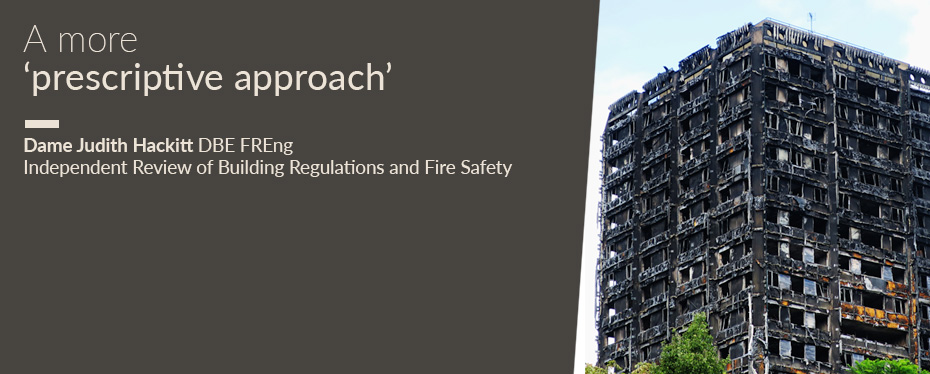
Dame Judith Hackitt reports the need for a more ‘prescriptive approach’ to building regulation.
The recommendations for the Building Control System published in the ‘Interim Report of Building Regulations and Fire Safety, Building a Safer Future’, https://www.gov.uk/government/publications/independent-review-of-building-regulations-and-fire-safety-interim-report in January were namely:
- Consultation by building control bodies and by those commissioning or designing buildings must place early together taking into account the fire and rescue service advice.
- Building control bodies to provide more fire safety information to the person carrying out the work to the responsible person for the building occupation; information on maintenance, fire risk assessment and proof of transferring the information.
- Developers need to ensure there is a formal review and handover process especially in high rise residential building, and phased occupation.
The report highlighted the vital importance of early consultation with the Fire and Rescue Authority for all new builds, extensions, structural alteration to, or relevant changes of use of buildings that are covered by a Fire Safety Order, FSO. The primary purpose of which is to obtain the views of the fire and rescue authority before approving full planning applications and reduce the risk that additional fire safety measure might be required after completion of building work on occupation or change of use. The aim is that fire safety can be fully designed in that helps to comply both building regulations and also the provisions of the Fire Safety Order.
There are a number of changes being recommended to Approved Documents, the first of which with be to revise the wording on assessments instead of testing, also known as desktop studies and secondly to clarify the whole document to make the process easier to use. The committee will be working closely with Building Regulations Advisory Committee (BRAC) on this. They are also exploring a wider approach to guidance contained in Approved documents and how it can be improved in the future.
A more ‘prescriptive approach’
Immediately following the release of Dame Judith’s interim report, a number of concerns about the scope of the review were raised by the Communities and Local Government Select Committee, chaired by Clive Betts MP, which have recently been addressed in a letter sent 5 March 2018.
Dame Judith’s letter addressed the following specific concerns raised on four key areas:
Part P
Concerns were made in particular around the exclusion of Part P. She acknowledged the concerns and cites that Part P will be added to the review of the overall structure of how the suite of guidance and recommendations work as a whole. “My aim is to ensure that the package works to deliver building integrity and is proportionate to the type of building work being undertaken”, she is quoted.
Hackitt also stated that the work that they will be undertaking in parallel as part of the review will be to look at the competence of all those who work in the construction and refurbishment of the fabric of the buildings.
Testing Electrical Appliances
Having been called on her to reconsider her view that the review should not examine the current regime for testing domestic electrical appliances, in her reply, she said the review would be limited to products that form an “integral part of the fabric of the building”, as opposed to appliances.
Cladding
On the use of cladding materials, Dame Judith says there is currently a choice between using products of “limited combustibility “or undergoing a full-system test. Current views vary on whether or not the guidance is clear on this. She writes, “For the future, my view is clear that the former is undoubtedly the low-risk option”.
“Where the person undertaking the work chooses the latter option, not only must they ensure that the full system is tested, but they must also ensure that the potential risks are mitigated by ensuring the system is properly installed and maintained throughout its life cycle.”
Prescription
On prescription she writes finally that, “My intention is to create a culture where there is a clear focus on building and maintaining safety throughout the lifetime of buildings, together with a system of regulation and enforcement that will encourage everyone to do the right thing and have appropriate penalties for those who fail to do so.
I believe that only an outcomes-based system can deliver this, as opposed to a system that ‘tells people what to do’, however that does not mean an absence of clear standards which must be achieved.
I do agree that there is a need for some prescription within regulations and guidance, but it is a system with clear roles and responsibilities, clear permission points and strong enforcement and sanctions that will drive the culture change towards intelligent thinking that will in turn deliver safe building outcomes.
Speaking after the letter was published, Mr Betts welcomed her comments that some degree of prescription was required.
“It’s telling that Dame Judith herself noted that current views varied as to whether the regulations permit the use of combustible materials in the cladding of high-rise buildings,” said the committee chair. “I have raised this in a series of parliamentary questions over the last month, and am yet to receive a satisfactory answer from the Government.”
Dame Judith will appear before the Committee when the final report is published this spring and cover the six areas identified in the initial report:
- Regulation and guidance
- Roles and responsibilities
- Competence
- Process, compliance and enforcement
- Residents’ voice and raising concerns
- Quality assurance and products
Further reading
The latest post-Grenfell Fire Safety Digest from the COC contains a number of articles of interest.
Read more in the CIC Fire Safety Digest issue 43, Link: https://mailchi.mp/cic/fire-safety-digest-853161?e=42043b9175

